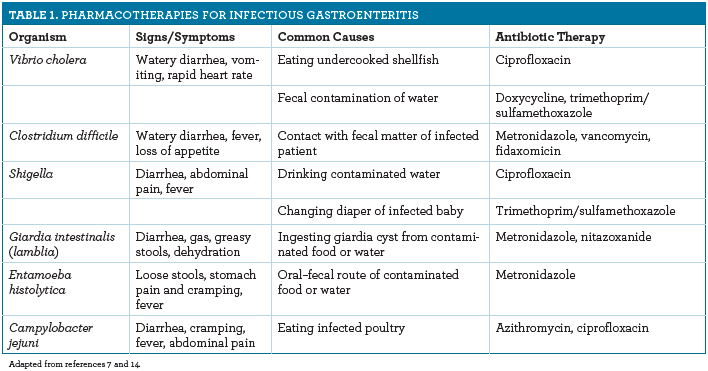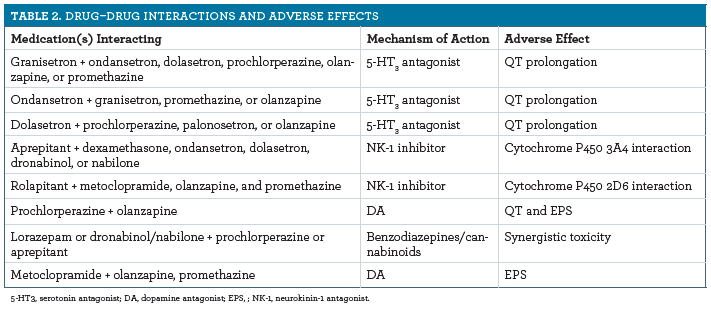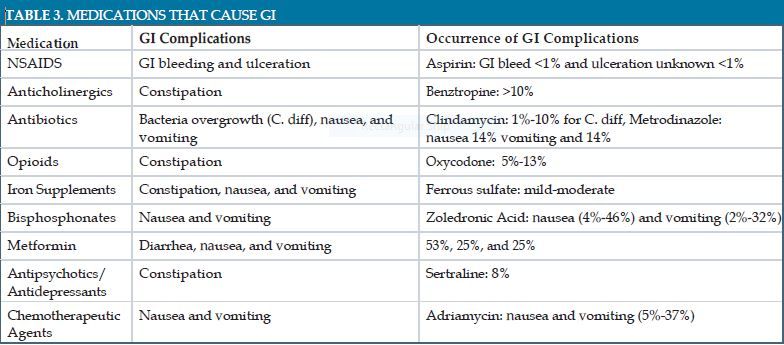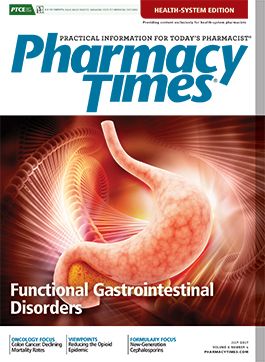Publication
Article
Pharmacy Practice in Focus: Health Systems
Functional Gastrointestinal Disorders
Author(s):
In 2013, a CDC study reported that gastrointestinal (GI)-related dysfunction was responsible for 13,011 annual outpatient office visits.
In 2013, a CDC study reported that gastrointestinal (GI)- related dysfunction was responsible for 13,011 annual outpatient office visits.1 These disorders can be classified as functional, structural, or biochemical, and they differ in presentation, symptoms, location, and severity of disease/ symptoms. Functional GI disorders (FGIDs) are the most common, affecting 40% of patients.2 This review does not cover all possible GI disorders; the goal is to present an overview of FGIDs commonly seen in an ambulatory/hospital setting.
GI tract disorders are treated, but also exacerbated, by several different classes of medications. The goal for health care providers is to treat the causative factor(s), not just the symptoms. The clinician’s evaluation and involvement in medication management are vital components of the treatment of GI disorders.
WHAT IS AN FGID?
FGIDs encompass dysfunctions in motility, mucosal membranes, the central nervous system, normal gut flora, and the immune system, as well as organ hypersensitivity.2 In addition, the normal motility of the GI tract may be shallower or prolonged and spasms may or may not be present, which can create pain ranging from mild to extremely intense.3 The three most important features of FGIDs are brain-gut dysfunction, sensation, and peristalsis.3
There are multiple exogenous factors that may hinder normal peristalsis, including the following4:
• Diet lacking in fiber or including excessive amounts of dairy products
• Inadequate intake of water
• Lack of exercise
• Change in lifestyle or daily routine
• Refusal to execute a bowel movement
• Use/overuse of certain medications
• Pregnancy
• Stress
The average adult in the Western hemisphere produces 2 to 3 bowel movements per day, 2 to 3 times per week.5 Therefore, when motility is affected, so are bowel habits. These sensorial changes occur because the nerves within the GI tract are highly sensitive, which cause an individual to experience pain while the body performs normal activities such as digestion.3 Braingut irregularities are caused by a malfunction in communication between these organ systems.3 Diagnostic tools, such as x-rays, may not detect obstructions and other structural abnormalities because these abnormalities are not a manifestation of functional disorders.
The Rome Foundation is an independent nonprofit dedicated to the treatment and awareness of FGIDs.6 The newest edition of its diagnostic criteria, Rome IV, outlines common symptoms, physiological abnormalities, typical pain experience, disease severity, and any other biological markers that are synonymous with the suspected disorder.6 The goal is refinement in the clinician’s treatment, accurate diagnosis of GI disorders, and improved quality of life for patients.
FUNCTIONAL DISORDERS OF THE GI SYSTEM
The GI system is an expansive system in the body. Disorders tend to be managed with OTC treatments for too long by patients rather than seeking proper attention from a health care professional.7 The diseases discussed in this section are the most common condition resulting from FGIDs for which patients seek treatment.
Infections top the list, with 135 million (33%) patients affected.1 These typically are related to other common conditions that disrupt the homeostasis of normal gut flora, such as gastroesophageal reflux disease (GERD), nausea, and vomiting, all of which may put the GI tract, especially the stomach and esophagus, at risk due to erosion of the epithelium lining from the stomach acid. The causative agents that are customarily responsible for GI infections are Escherichia coli, Shigella, Campylobacter, Clostridium difficile, rotavirus, and parasites such as giardia.8
GERD (more commonly known as acid reflux) is characterized by the backflow of stomach acid, secondary to inadequate closure of the lower esophageal sphincter muscles that separate the esophagus and the stomach.9 As a chronic disorder, GERD causes many patients to seek OTC interventions for relief,7,9 which makes clinician involvement imperative for the proper diagnosis and treatment of this disease.9
Constipation and hemorrhoids are similar in that they have the greatest relation to a patient’s external habits and exposures. The most common origin of these disorders is insufficient fiber intake,4 although opioid use is a major risk factor. These simple disorders have the potential to escalate into more serious problems such as anal fissures, fistulas, or abscesses.4
Diverticulitis, another result of inadequate fiber intake, is the occurrence of protrusions of the muscular wall of the intestines that can weaken the structure to the point of creating severe complications, including infection, obstruction, inflammation, and bleeding.4,9
Peptic ulcer disease (PUD) encompasses ulcerations that jut deep into the muscularis mucosae of the GI tract. Helicobacter pylori, overuse of nonsteroidal anti-inflammatory drugs, and stress are the 3 main causes agents of PUD.9 Diet, tobacco use, and excessive amounts of stress must be reduced substantially to properly treat PUD.9 It is critical to balance pharmacologic and nonpharmacologic interventions to appropriately treat this disorder.
Irritable bowel syndrome (IBS), irritable bowel disease (IBD), and celiac disease make up the remaining common FGIDs. IBS is the byproduct of a spastic colon, which causes sporadic and uncontrollable bowel habits, gas, and bloating.7 IBDs, such as ulcerative colitis (UC) and Crohn’s disease (CD) occur because of lesions within the GI tract. This immunological disease can be more difficult to treat because it originates from hypersensitive immunoresponses.7 CD affects a patient’s ability to properly absorb key nutrients. Therefore, patients who consume gluten expose their digestive tracts to a heightened immune response, which results in problematic bowel habits, bloating, vomiting, weight loss, anemia, or seizures.7
PHARMACOLOGIC THERAPIES FOR FGIDS
In general, antibiotic drug therapy consists of various therapy categories, and may include beta-lactams, vancomycin, and fluoroquinolones.
Anaerobic coverage may be maximized with the addition of metronidazole and piperacillin-tazobactam. Vancomycin is frequently used in patients who are allergic to beta-lactams or cephalosporins. Prebiotics and probiotics help to replenish normal flora after antibiotic use. Overall, the selection of antibiotic coverage is determined by the suspected infecting organism and microbiology cultures and requires a thoughtful review of patient history, microbiology cultures, and previous antibiotic treatment. Table 1 enumerates the drug therapies used in infectious gastroenteritis.10-15
When selecting an appropriate drug therapy, it is important to ensure that both the disorder’s underlying cause and the patient’s symptoms are being treated. The appropriate dosage also is critical, as the best therapeutic option may require a plan that encompasses pharmacologic and nonpharmacologic selections. Further, with the increased frequency of administration and use of multiple drugs, clinicians must be vigilant about the risk of patients’ nonadherence to treatment plans/medications and of drug—drug interactions.
Proton pump inhibitors (PPIs) and histamine2 (H2)-receptor antagonists are staples of many GI disorders. Because these are OTC medications, it is important to monitor their use and counsel patients on possible adverse effects (AEs). H2-receptor antagonists block the H2 receptor within the stomach, which prevents the secretion of acid. Similarly, PPIs block the secretion of hydrogen ions. Clostridium difficile overgrowth is common with overuse of these medications.16 Ultimately, thesemedications increase the pH of the stomach. Calcium analogs also may be used to increase the pH of the stomach; however, they usually do not have enough potency to provide relief.
Antiemetics are the most common medications used in GI disorders; examples include serotonin antagonists (5-HT3), dopamine antagonists (DAs), and neurokinin-1 receptor antagonists. These classes collectively inhibit the chemoreceptor trigger zone of the brain, which ameliorates nausea and vomiting in some patients. Utilization of a 5-HT3 or a DA may generate a drug—drug interaction and result in QT prolongation. When macrolides are used as prokinetic agents and combined with antiemetics, patients should be monitored carefully and their comorbid conditions evaluated. In some patient groups, a diagnostic electrocardiogram and the possibility of cardiac arrhythmia should be considered. Many of these agents may have interactions with cytochrome P450 (table 2). The nontraditional antiemetics that may be used in some instances are steroids, benzodiazepines, and cannabinoids.
Biologics and nonbiologics are classes exclusive to CD because of their immunosuppressant activity. Patients receiving these medications should have their liver, kidney, and cardiac functions monitored, as well as their differential white blood cell count, depending on the medication. They should avoid live vaccines and individuals with infectious disease(s) or those at risk of contracting them. Steroids used for UC and CD also can be grouped into this immunosuppressant pharmacotherapy class. Aminosalicylates provide local immunosuppression and are reserved for lesions of the GI tract.
MEDICATIONS THAT WORSEN GI FUNCTION
When evaluating patient choices, it is important to assess the risk—benefit ratio being presented. GI-protective medications, such as PPIs or misoprostol, reduce the risk of complications. Some cases, however, necessitate a GI-toxic medication.online table 3 reviews common medications and their AEs on the GI system.17
CLINICIAN INVOLVEMENT
Treatment for GI disorders should include pharmacologic and nonpharmacologic methodologies,18 with modifications to patients’ diets and lifestyles and the institution of an exercise regimen serving as the foundation.18 Clinicians should stress the importance of adequate nutrition, fiber intake, hydration, and exercise; avoiding tobacco smoking/chewing, overuse of alcohol, and abuse of prescription/illicit drugs; and specific, measurable, attainable, realistic, and time-based goals.19 In counseling patients, clinicians must educate patients on why they need to adhere to all aspects of the treatment plan.18
CONCLUSION
Patients tend to manage FGIDs with OTC interventions for too long rather than seeking proper attention from a health care professional effectively to treat the disease. The key to the proper treatment of GI disorders is to treat the source of the disease quickly and efficiently. Clinicians have many opportunities to intervene with patients to improve their overall quality of life.
Jerry Barbee Jr. and Mina Ilia are clinical pharmacists at HCA West Florida Hospital, Pensacola; Jospeh Adelufosi is a PharmD candidate at the University of
South Florida, Tampa; and Aerikia O’Neal-Scott is a PharmD candidate at Florida Agricultural & Mechanical University, Tallahassee.
Resources










